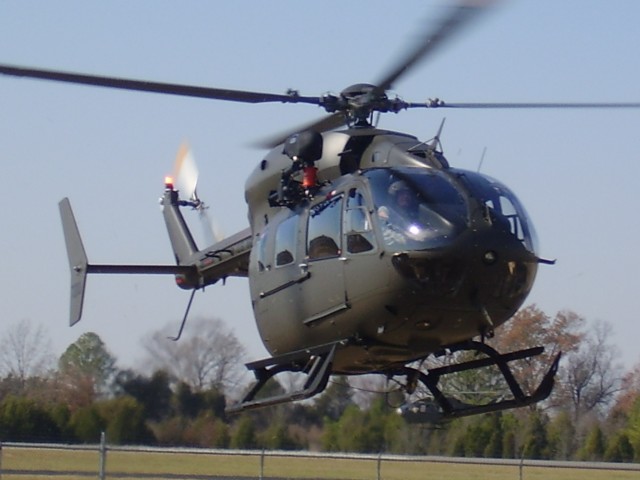REDSTONE ARSENAL, Ala (Army News Service, Feb. 20, 2008) -- Rosebud Sioux tribal leaders joined the Army Feb. 5 to celebrate the proud name for a new Army helicopter - the UH-72A Lakota.
The Army's Utility Helicopter Project Office marked inception of the new Lakota helicopter fleet with a ceremony at Redstone Arsenal, Ala., attended by Rosebud Sioux tribal council president Rodney Bordeaux, his chief of staff and the tribe's chief, among others.
"It is a great honor to have our name out there now where people can see it," said Bordeaux. "It is an honor to have the tradition of our warriors and veterans going on. We exist today because of our treaty with the federal government." Twenty Lakota aircraft have been delivered ahead of schedule and are flying out of three bases in the United States. They are meeting the mission within budget requirements, project officials said, adding there are plans to expand operations to both Europe and Japan. There was a reason behind the naming of the new helicopter, officials said. First, a Department of Defense regulation, DoD 4120-15, stipulates that the name of a new helicopter must be Native American in origin. The process began when the project office announced a search for candidates to the Program Executive Office for Aviation community. Supporting documentation was required to explain why the name submitted was a good candidate for this particular helicopter and how it fit the mission. Out of the names received, the search narrowed to three candidates: Crow, Lakota and Cherokee. The Lakotas, a part of the seven confederations making up the Sioux nation, were known as a peaceful, non-aggressive people that lived by hunting buffalo on horseback. The Lakota helicopter is a non-arms-bearing helicopter that performs medical and casualty evacuations, provides disaster relief, aids in homeland defense and also works to counter drugs and narcotics. This name was selected, but the process wasn't over. "It (the Lakota) fulfills a plethora of missions, if you will, all of them being non-combat," Stephen Hart, LUH maintenance manager, said. "Sometimes it is hard to find a good match. When we settled on Lakota, we went to the Lakota tribe to ask their permission because that is part of the process." Once the name was settled, the UH project office contacted the Bureau of Indian Affairs. The bureau provided guidance explaining that because the Lakotas were a part of the Sioux nation, the Army had to contact and obtain approval from a majority of the council members making up the Sioux Nation. "We sent out e-mails, faxes, called them - those chairpersons are as busy as we are," Hart said. The approval process normally takes 12 to 18 months. The UH project office accomplished this in six. The driving force behind this was to receive the necessary permissions in time to field the first aircraft in December 2006. The concurrences were then sent to the Army Materiel Command to prepare a packet. This in turn was sent to the Air Force program manager and then to the Pentagon. "The Air Force is the approving authority for all mission/design/series as well as popular names of aircraft. These packets must include descriptions of the aircraft, cage code, manufacturer information and other supporting documentation," Hart said. The popular name and MDS approvals were worked simultaneously. Once it was approved, it became known as the UH-72A Lakota. "Being consistent with the fact that we as a nation staff the war fighters," Hart said, explaining why aircraft are named after Indian tribes. "That is our job to protect the nation and we do that with war fighters and war fighting equipment. The Indians were basically known as protectors of their land and war fighters. I think there is a resemblance there."
(Barbara Cummings writes for AMCOM Public Affairs.)




Social Sharing